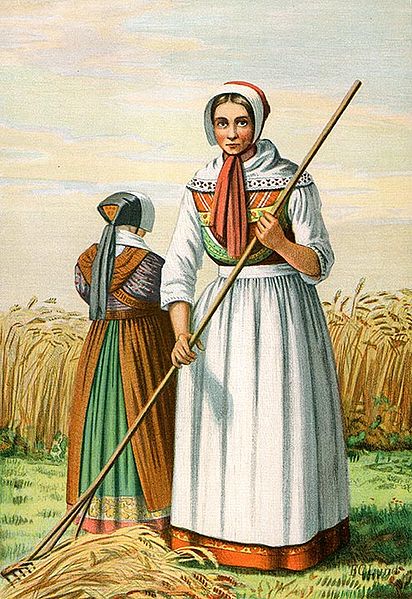 The style and design of the traditional clothes in Denmark usually date back to 1750-1900 (some even say 1750-1850). This is the period when Danish national attire was formed. People made their garments at home by themselves or ordered from artisans specializing in certain clothing/accessories, so the techniques and skills were passed down through the generations. Of course, fashion influenced the style of outfits worn by men, women, and children, bringing changes and novelties, but the main features remained.
The style and design of the traditional clothes in Denmark usually date back to 1750-1900 (some even say 1750-1850). This is the period when Danish national attire was formed. People made their garments at home by themselves or ordered from artisans specializing in certain clothing/accessories, so the techniques and skills were passed down through the generations. Of course, fashion influenced the style of outfits worn by men, women, and children, bringing changes and novelties, but the main features remained.
The majority of Danish traditional garments were made from wool and linen, the most available and cheap materials. The locals used 3 different fabrics: vadmel – woolen fabric, lærred – linen fabric, and hvergarn – a mix of wool and linen.
If to talk about the design of Danish folk clothing, we can say that men’s outfits from the 18th century are characterized by long waistcoats, frock coats, and knee-length breeches, while the 19th-century costumes include short waistcoats, frock coats, and full-length pants.
Women’s 18th-century traditional attire usually consists of a 2-piece dress, with a laced bodice or jacket and a long wide skirt. And women’s 19th-century apparel is characterized by a dress where the top and bottom parts are made from the same fabric.
Also, we should mention that Danish male traditional attire is a lot less colorful, eye-catching, and diverse than women’s. There are fewer variations in style and design. And men’s outfits vary less from region to region.
The typical Danish male outfit includes a shirt, knee-length breeches or full-length trousers (depending on the time period and region), a waistcoat (typically red), a coat or jacket, a headdress, high hand-knit white stockings, and shoes (clogs, high leather boots, or dress shoes with a buckle on top).
Interesting fact! Danish traditional shirt worn by men was often sewn from 15 separate pieces, which had to be cut from a single piece of linen (for the sake of cutting the costs). So not your usual simple tunic!
The typical Danish female outfit includes a blouse, a 1-piece or 2-piece dress (a bodice or jacket and a skirt), an apron, a headpiece, a shawl or scarf that covered the neck and shoulders, stockings, and shoes (the same as male footwear).

En Hedebopige (A Young Girl from Hedebo), lithograph by Danish artist Frederik Christian Lund illustrating a Danish national costume from “Danske Nationaldragter” (1864)
The most diverse and worth studying piece of women’s attire in Denmark is the headdress. There were many options, designs, and types – from bonnets typical for Northern Europe to kerchiefs, wimples, caps, etc. But different variations of a bonnet are the most typical.
On a Danish folk costume, you usually won’t see a lot of embroidery, although there is some of it on shirts, aprons, and headpieces. But Danish women were rather skilled in weaving because the majority of clothes were hand-woven from wool. In the 18th-19th century, practically every family owned at least 3-7 sheep to have wool for their clothing.
The traditional Danish attire looks typically Scandinavian, with its warm woolen garments, unique headdresses, rows of metal (often, silver) buttons on waistcoats and jackets, wooden clogs, and favored red color. Many local outfits also look no-nonsense and functional, with few decorations. At the same time, these folk costumes are charming.


